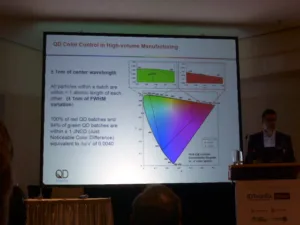Peter Kazlas is director of advanced product development at QD Vision, which produces Color IQ quantum dots; these began to be shipped in early 2013. Color IQ optics use red and green QDs with a blue LED light source.
The display industry has invested billions of dollars into increasing screen size and the quality of resolution, contrast and brightness. Talk has also recently turned to better colour performance. QDs can be used to enhance display colours, with the colour that they affect depending on the size of the QD. Blue QDs are the smallest and red are the largest.
QDs are operated in two ways: photoluminesence (PL mode) and electroluminesence (EL mode). PL mode is the one that most display makers are familiar with: the dots are activated by light energy and convert colour from other light sources. EL mode is the emissive form of quantum dots, which are activated by electronic energy and directly emit coloured light. These require charge transfer films and are often referred to as ‘QLEDs’. In his speech, Kazlas focused on PL mode QDs.
Displays using quantum dots achieve very accurate colours, said Kazlas. All dots in a batch are within one atomic length of each other; additionally 100% of red batches and 94% of green batches (the colours that Color IQ uses) are within one Just Noticeable Colour Difference (JND). The result is very uniform colour.
Quantum dots are ‘the only practical path’ to Rec.2020, said Kazlas – at least in the home (digital cinema laser projectors can reach around 99% coverage). A display with QDs can cover about 95% of Rec.2020, while RGB LEDs cover about 87%. WOLED displays are dependent on the filters used; leaky filters limit coverage to around 66%.
Today’s QD TVs range from $1,300 to about $6,000. Touch Display Research estimates that the QD market will grow from $75 million in 2013 to $10.6 billion in 2025.
Kazlas listed the advantages of using QDs in printed electronics. These include: tunability, narrow band emissions; low cost processing; energy efficiency; low operating voltage; and higher robustness due to only being 50% organic. They can also be formulated for multiple types of printing, such as slot-die coating.
For printed QLEDs to be possible, printed OLEDs must be possible. Kazlas believes that we will see demonstrations within one-to-two years.

